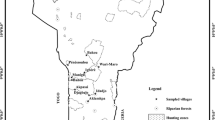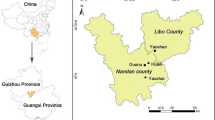Abstract
Bidding Customs and Habitat Improvement for Matsutake (Tricholoma matsutake) in Japan. A brief history of Japan’s matsutake production, use, and management is presented, with emphasis on habitat improvement efforts and the land use tradition of iriai. Bidding systems for allotment of matsutake gathering rights are discussed. Three villages with different bidding systems are compared to see what effects the bidding systems have on village finances, matsutake production, and matsutake habitat enhancement. Contrary to expectations, habitat for matsutake was not improved when land owners were guaranteed the gathering and selling rights to matsutake growing on their own lands. Instead, habitat improvement was most successful and matsutake production was highest on community-owned lands in Oka Village, where the iriai tradition is strongest.


Similar content being viewed by others
Literature Cited
Akimichi, T. 1995. Cultural History of Territory: Society and Resources of Sea, Forest and River. Shogakukan, Tokyo (in Japanese).
———. 2004. Anthropology of the Commons. Jinbun shoten, Tokyo (in Japanese).
Amaranthus, M. P., D. Pilz, A. Moore, R. Abbott, and D. Luoma. 2000. American Matsutake (Tricholoma magnivelare) across Spatial and Temporal Scales. USDA Forest Service Gen. Tech. Rep. PSW-GTR-178.
Arioka, T. 1997. Matsutake: The Series of Cultural History between Materials and Human, No. 84. Hosei University Press, Tokyo, Japan (in Japanese).
Chiba, T. 1991. A Study of Bald Mountains. Enlarged and revised edition. Soshiete, Tokyo (in Japanese).
Forestry Agency (Japan). 2006. Survey for NTFP Supply and Demand. URL: http://www.rinya.maff.go.jp/puresu/h18-8gatu/0804tokusan.html (in Japanese).
Fujita, H. 1987. The Effects of Habitat Improvement of Matsutake in Kyoto Prefecture—From Questionnaire Survey. Matsutake-Kaiho 26:2 (in Japanese).
Fukuchiyama Region Agency. 1981. Problems of Forest Management for Matsutake. Matsutake-Kaiho 6:1 (in Japanese).
Hamada, M. 1964. A Brief History of Matsutake Studies. Pages 218–220 in The Matsutake Research Association, ed., Matsutake: Its Studies and Economic Production of the Fruit-Body. Kyoto, Japan (in Japanese).
Hardin, G. 1968. The Tragedy of the Commons. Science 162:1243–48.
Hatanaka, H. 2004. History and Recent Activities of Ayabe Matsutake Producing Association. Matsutake-Kaiho 38:5–6 (in Japanese).
Hori, K. 1979. Comments for Inaugural Issue of “Matsutake-Kaiho.” Matsutake-Kaiho 1:1 (in Japanese).
Hosford, D., Pilz, D., Molina, R., and Amaranthus, M. 1997. Ecology and Management of the Commercially Harvested American Matsutake Mushroom. Gen. Tech. Rep. PNW-GTR-412. Portland, OR: U.S. Department of Agriculture, Forest Service, Pacific Northwest Research Station.
Inoue, M. and Miyauchi, T., eds. 2001. Sociology of the Commons. Shinyo sha, Tokyo (in Japanese).
Ishida, M. 1932. The Historical Study on the Japanese Traditional Land Ownership System “Sōyu.” Iwanami shoten, Tokyo (in Japanese).
Ito, T. and Iwase, K. 1997. Matsutake—Propagation and Cultivation with a View of Orchard—Nosangyoson Bunka Kyokai, Tokyo, Japan (in Japanese).
Japan Special Forest Product Promotion Association. 2004. Transition of Mushroom Production (1971–2004). URL: http://www.nittokusin.jp/07_toukei/pdf/kinoko_seisan_ryo2004.pdf (in Japanese).
Kada, Y. 1997. Multiple Ownership Derived from Everyday Life Practice. Journal of Environmental Sociology 3:72–85 (in Japanese).
Kyoto Central Wholesale Market No. 1. 2007. Annual Report. URL: http://www.city.kyoto.jp/sankan/dai1sijo/toukei/nenpo/H18nenpo/H18/hinmokuyasai.pdf (in Japanese) (April 26, 2007).
Kyoto Prefecture Agriculture, Forestry and Fishery Agency. 2007. Statistics of Forestry in Kyoto. URL: http://www.pref.kyoto.jp/rinmu/resources/1166510205214.pdf.
Kyoto Prefecture Forest Experiment Station. 1977. Matsutake Part III—The Way to Enhance Production. Forestry Research Center of Kyoto (in Japanese).
Matsutake Research Association, The. 1983. How to Make Matsutake Forests. Sobun, Tokyo, Japan (in Japanese).
McKean, M. A. 1992. Management of Traditional Common Lands (Iriaichi) in Japan. Pages 63–98 in Daniel Bromley et al., eds., Making the Commons Work: Theory, Practice, and Policy. Institute of Contemporary Studies.
Metropolitan Wholesale Market. 2006. Market Statistics Information. URL: http://www.shijou-tokei.metro.tokyo.jp/asp2/searchresult2.aspx?page = 1&mode = 1&smode = 20&s = 2006|1|2006|12|0|3|80|382000&h = false (in Japanese).
Ministry of Finance (Japan). 2007. Trade Statistics of Japan. URL: http://www.customs.go.jp/toukei/info/index_e.htm (April 26, 2007).
Motoyoshi, R. 1980. Common Forestry System and Bidding Institution of Matsutake. Bulletin of Forest Research Center of Kyoto:72–73 (in Japanese).
———. 1983. Common Forestry System and Bidding Institution of Matsutake (IV): Problems of Bidding Institutions of Matsutake. Bulletin of Forest Research Center of Kyoto:72–73 (in Japanese).
———. 1989 Historical Changes of the Matsutake Mushrooming in Kyoto Since the Mid-17th Century, with Special Reference to its Relations with the Common Forestry System. Bulletin of the Tokugawa Institute for the History of Forestry 23:1–25 (in Japanese).
Murakami, T. 1988. Halt the People’s Unconcern for Forests: Abolish the Whole Bidding System to Release Private Forests from Village Governance as a First Step. Matsutake-Kaiho 27:1 (in Japanese).
Murota, T. and Mitsumata, G. 2004. Iriai Forests and Commons. Nihon Hyoron Sha, Tokyo (in Japanese).
Nagasakiya, K. 1993. A Research about Bidding Customs of Matsutake Forests in Tanba Area, Kyoto Prefecture. Graduation thesis, Kyoto University (in Japanese).
Nakamura, H. and Tsurumi, Y., eds. 1995. The Sea of the Commons. Gakuyo shobou, Tokyo (in Japanese).
Ogawa, M. 1978. Biology of Matsutake Mushroom. Tsukiji Shokan, Tokyo (in Japanese).
Suga, Y. 2004. Re-examination of Sōyu-Theory as Social Equalization System. In H. Terashima, ed., Anthropological Studies about Equality and Inequality. Nakanishiya, Kyoto (in Japanese).
———. 2006. People and River in Japan: Successful Commons Management and the Influence of Politics. Yoshikawa Kobunkan, Tokyo (in Japanese).
Sugihara, H. 1994. The Japanese Commons, “Iriai.” In H. Uzawa and A. Mogi, eds., Social Common Capital. Tokyo University Press, Tokyo (in Japanese).
Tabeta, M. 1990. Economics of the Commons. Gakuyo shobou, Tokyo (in Japanese).
Tominaga, Y. and Yoneyama, M. 1978. Practice of Matsutake Cultivation. Yokendo, Tokyo, Japan (in Japanese).
Torigoe, H. 1997. Who Gets the Most from the Commons. Journal of Environmental Sociology 3:5–14 (in Japanese).
Wang, Y., Hall, I. R., and Evans, L. A. 1997. Ectomycorrhizal Fungi with Edible Fruiting Bodies 1. Tricholoma Matsutake and Related Fungi. Economic Botany 51(3):311–327.
Yamagishi, T. 1980. Research Concerned with Techniques of Producing Matsutake: Results of 1979 and Plans of 1980. Matsutake-Kaiho 5:1 (in Japanese).
Yoshimura, F. 2000. How to Produce Matsutake Mushroom Forest in Iwaizumi Town. Iwaizumi Institute for Matsutake Mushroom, Iwaizumi Town, Japan (in Japanese).
———. 2004. The Newest Technology in Matsutake Mushroom Cultivation: New Ideas and Methods in Matsutake Mushroom Forest Revival. Tronto, Tokyo (in Japanese).
Acknowledgments
This paper is one result of the research project, “Comparative Studies of Communal Forests in Japan and Britain: Approaching from the View Point of the Commons Theory,” supported by a grant from the University of Hyogo. This paper has also benefited from the workshop discussions of another research project, “Distribution and Sharing Resources in Symbolic and Ecological Systems: Integrative Model-building in Anthropology” (Representative: Dr. Tomoya Akimichi of Research Institute for Humanity and Nature).
We wish to offer special thanks for encouragement and support to Dr. Anna Tsing, of the University of California, Shiho Satsuka, of University of Toronto, and David Arora, who not only gave us an opportunity to publish this paper but also revised our rough draft and corrected many errors. We thank Ms. Okuda for her prompt and attentive help in translating this article into English. And we appreciate Mr. Tasuku Joke and Mr. Hideki Hatanaka of Kyoto Prefecture and the inhabitants of Kanegawachi, Takatsu, and Oka villages for their cooperation and help in this study. Finally, we thank the Centre for Manx Studies for their support in the final discussions between the coauthors.
Author information
Authors and Affiliations
Corresponding author
Rights and permissions
About this article
Cite this article
Saito, H., Mitsumata, G. Bidding Customs and Habitat Improvement for Matsutake (Tricholoma matsutake) in Japan. Econ Bot 62, 257–268 (2008). https://doi.org/10.1007/s12231-008-9034-7
Published:
Issue Date:
DOI: https://doi.org/10.1007/s12231-008-9034-7




